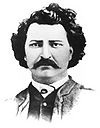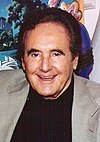Portal:Cartoon
The Cartoon Portal

A cartoon is a type of visual art that is typically drawn, frequently animated, in an unrealistic or semi-realistic style. The specific meaning has evolved, but the modern usage usually refers to either: an image or series of images intended for satire, caricature, or humor; or a motion picture that relies on a sequence of illustrations for its animation. Someone who creates cartoons in the first sense is called a cartoonist, and in the second sense they are usually called an animator.
The concept originated in the Middle Ages, and first described a preparatory drawing for a piece of art, such as a painting, fresco, tapestry, or stained glass window. In the 19th century, beginning in Punch magazine in 1843, cartoon came to refer – ironically at first – to humorous artworks in magazines and newspapers. Then it also was used for political cartoons and comic strips. When the medium developed, in the early 20th century, it began to refer to animated films that resembled print cartoons. (Full article...)

In print media, a cartoon is a drawing or series of drawings, usually humorous in intent. This usage dates from 1843, when Punch magazine applied the term to satirical drawings in its pages,[1] particularly sketches by John Leech.[2] The first of these parodied the preparatory cartoons for grand historical frescoes in the then-new Palace of Westminster in London.[3]

Selected article -
Louis Riel is a 2003 historical biography in comics by Canadian cartoonist Chester Brown. It deals with the relationship of Métis rebel leader Louis Riel (pictured) with the newly established Canadian government. It begins shortly before the 1869 Red River Rebellion, and ends with Riel's 1885 hanging for high treason. The book explores the possibly schizophrenic aspect of Riel's personality—he believed God had named him Prophet of the New World, destined to lead the Métis people to freedom. The work is noted for its emotional disengagement, its intentionally flat dialogue, and a minimalist drawing style inspired by Harold Gray's comic strip Little Orphan Annie. The lengthy, hand-lettered appendix provides insight on Brown's creative process and biases, and highlights where he changed historical facts to create a more engaging story. It was the first comic book to receive a grant from the Canada Council for the Arts. It was critically well received, and won three Harvey Awards. The original serialization (1999–2003) sold poorly, but the book version was a surprise bestseller. Its success played a major part in gaining shelf space for serious graphic novels in mainstream North American bookstores.
Selected character -
Bugs Bunny is a funny animal cartoon character, best remembered for his starring roles in the Looney Tunes and Merrie Melodies series of theatrical shorts produced by Warner Bros. during the Golden Age of American animation. His popularity during this era led to his becoming a corporate mascot of Warner Bros. Entertainment. Bugs is an anthropomorphic gray hare or rabbit and is famous for his flippant, insouciant personality, a pronounced New York accent, his portrayal as a trickster, and his catch phrase "Eh... What's up, doc?" (usually said while chewing a carrot). Bugs has appeared in more films than any other cartoon character and is the ninth most portrayed film personality in the world. In reality, he was brought to life by the animators and staff of Leon Schlesinger Productions (later Warner Bros. Cartoons): including Tex Avery, who directed Bugs' "official" debut short A Wild Hare (1940); Robert McKimson, who created Bugs' definitive character design; and Mel Blanc, who originated the voice of Bugs.
Did you know... -
- ...that William Hanna claimed that the Tom and Jerry character Jerry Mouse was named Jinx in his first appearance while Joseph Barbera claimed that the mouse went nameless?
- ...that the Young Justice episode "Independence Day" introduces a younger version of the DC Universe?
- ...that the Sam Sheepdog and Ralph Wolf cartoons Sheep Ahoy, A Sheep in the Deep, and Don't Give Up the Sheep were censored by ABC to remove a dynamite stick, a smoke break scene, and a spanking scene respectively?
Selected list -
The Hugo Award for Best Graphic Story is given each year for science fiction or fantasy stories told in graphic form and published in English or translated into English during the previous calendar year. The Hugo Award for Best Graphic Story has been awarded annually since 2009. It was started then with the requirement that it would only continue as an official award if approved again by the World Science Fiction Society after that year. It was, and was again awarded in 2010; it will need to be ratified again after the 2012 awards in order to continue. Hugo Award nominees and winners are chosen by supporting or attending members of the annual World Science Fiction Convention, or Worldcon, and the presentation evening constitutes its central event. The selection process is defined in the World Science Fiction Society Constitution as instant-runoff voting with five nominees, except in the case of a tie as happened in 2009. In the four years that the award has been active, twenty-one works from twelve series have been nominated. Girl Genius, written by Kaja and Phil Foglio, drawn by Phil Foglio, and colored by Cheyenne Wright, won the first three awards.
General images -
Selected biography -
Joseph Barbera (1911–2006) was an influential American animator, film director, film producer, storyboard artist, and cartoon artist. Born in New York City, after working odd jobs and as a banker, Barbera joined Van Beuren Studios in 1932 and subsequently Terrytoons in 1936. He met his lifelong collaborator William Hanna while working for Metro-Goldwyn-Mayer in 1937 and soon began producing animated shorts such as the Tom and Jerry series. In 1957, after MGM dissolved their animation department, they co-founded Hanna-Barbera, which became the most successful television animation studio in the business, producing programs such as The Flintstones, The Huckleberry Hound Show, Top Cat, The Jetsons, Scooby-Doo, The Quick Draw McGraw Show, The Smurfs, Wacky Races and Yogi Bear. Hanna and Barbera won seven Academy Awards and eight Emmy Awards. Their shows, which have translations in more than 20 languages, had a global audience in the 1960s of over 300 million people.
Subcategories
WikiProjects
- Main projects
- Arts • Animation • Comics • Entertainment • Visual arts
- Related Projects
- Anime and manga • Biography • Film • Fictional characters • Media franchises • Music • Television • Video games
Selected quote -
Topics
- Comic book
- Comic strip
- Digital comics
- Graphic novel
- Mobile comic
- Motion comics
- Trade paperback
- Webcomic
- Animator
- Animation director
- Animation studios
- Animation film festivals
- Feature-length films
- Short films
- Television series
- Computer-animated films
- Stop-motion films
- Traditional animation
- Limited animation
- Rotoscoping
- Stop Motion
- Clay
- Cutout
- Graphic
- Model
- Object
- Pixilation
- Puppetoon
- Computer animation
- Flash animation
- PowerPoint animation
- SVG animation
- Cel-shaded animation
- Crowd simulation
- Morph target animation
- Motion capture
- Non-photorealistic rendering
- Skeletal animation
Things you can do

- Requested articles: Fenwick (comics), Khimaera (comics), Mutant Underground Support Engine, Bruce J. Hawker, Marc Dacier, Hultrasson, Frankenstein Comics, Dave Johnson (comics), Paco Medina, Dappere Dodo, New Adventures of the Space Explorers, Habatales, Musical Box, Foo-Foo (TV series), Bonne nuit les petits, The Adventures of Lariat Sam, More...
- Images and photos needed: Request images that are needed from Wikipedia requested images of comics and animation to included in each articles.
- Stubs: Work on stubs in articles in Comics and Animation stubs.
- Infobox: Add infobox that are needed from Category:Comics articles without infoboxes and Category:Animation articles needing infoboxes in articles.
- Deletion sorting: Please see the collection of discussions on the deletion of articles related to comics and animation - compiled by WikiProject Deletion sorting
Related portals
Associated Wikimedia
The following Wikimedia Foundation sister projects provide more on this subject:
-
Commons
Free media repository -
Wikibooks
Free textbooks and manuals -
Wikidata
Free knowledge base -
Wikinews
Free-content news -
Wikiquote
Collection of quotations -
Wikisource
Free-content library -
Wikiversity
Free learning tools -
Wiktionary
Dictionary and thesaurus
More portals
Sources
- ^ Punch.co.uk. "History of the Cartoon". Archived from the original on 2007-11-11. Retrieved 2007-11-01.
- ^ Adler & Hill 2008, p. 30.
- ^ "Substance and Shadow: Original Editorial Accompanying "Cartoon, No. I"". Victorian web.org. Retrieved 29 October 2023.










































